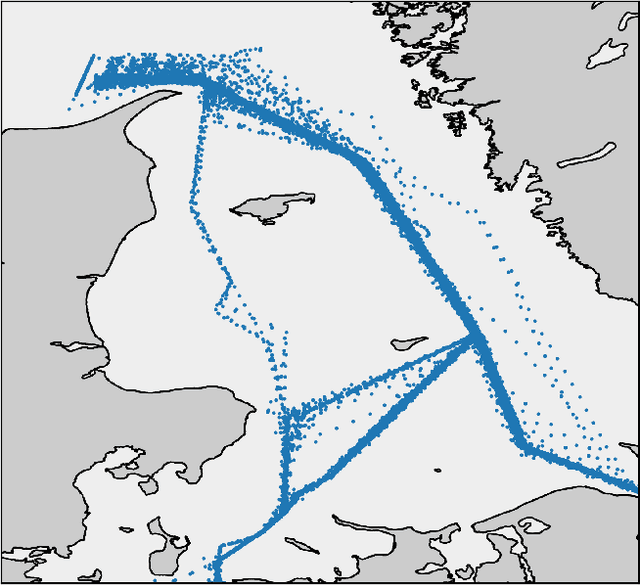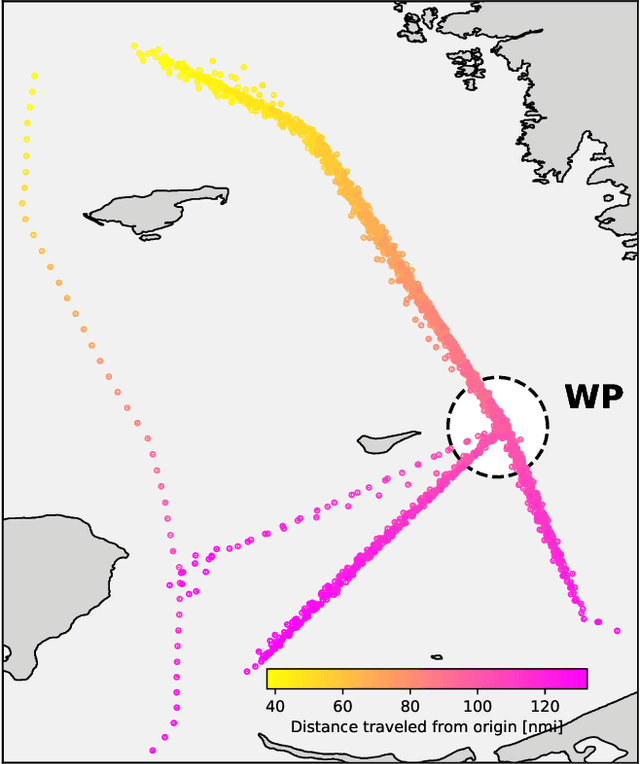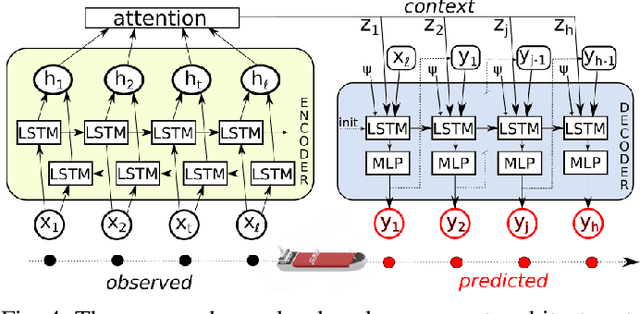Samuele Capobianco
Recurrent Encoder-Decoder Networks for Vessel Trajectory Prediction with Uncertainty Estimation
May 11, 2022



Abstract:Recent deep learning methods for vessel trajectory prediction are able to learn complex maritime patterns from historical Automatic Identification System (AIS) data and accurately predict sequences of future vessel positions with a prediction horizon of several hours. However, in maritime surveillance applications, reliably quantifying the prediction uncertainty can be as important as obtaining high accuracy. This paper extends deep learning frameworks for trajectory prediction tasks by exploring how recurrent encoder-decoder neural networks can be tasked not only to predict but also to yield a corresponding prediction uncertainty via Bayesian modeling of epistemic and aleatoric uncertainties. We compare the prediction performance of two different models based on labeled or unlabeled input data to highlight how uncertainty quantification and accuracy can be improved by using, if available, additional information on the intention of the ship (e.g., its planned destination).
Deep Learning Methods for Vessel Trajectory Prediction based on Recurrent Neural Networks
Jan 07, 2021



Abstract:Data-driven methods open up unprecedented possibilities for maritime surveillance using Automatic Identification System (AIS) data. In this work, we explore deep learning strategies using historical AIS observations to address the problem of predicting future vessel trajectories with a prediction horizon of several hours. We propose novel sequence-to-sequence vessel trajectory prediction models based on encoder-decoder recurrent neural networks (RNNs) that are trained on historical trajectory data to predict future trajectory samples given previous observations. The proposed architecture combines Long Short-Term Memory (LSTM) RNNs for sequence modeling to encode the observed data and generate future predictions with different intermediate aggregation layers to capture space-time dependencies in sequential data. Experimental results on vessel trajectories from an AIS dataset made freely available by the Danish Maritime Authority show the effectiveness of deep-learning methods for trajectory prediction based on sequence-to-sequence neural networks, which achieve better performance than baseline approaches based on linear regression or feed-forward networks. The comparative evaluation of results shows: i) the superiority of attention pooling over static pooling for the specific application, and ii) the remarkable performance improvement that can be obtained with labeled trajectories, i.e. when predictions are conditioned on a low-level context representation encoded from the sequence of past observations, as well as on additional inputs (e.g., the port of departure or arrival) about the vessel's high-level intention which may be available from AIS.
Vehicle classification based on convolutional networks applied to FM-CW radar signals
Oct 31, 2017



Abstract:This paper investigates the processing of Frequency Modulated-Continuos Wave (FM-CW) radar signals for vehicle classification. In the last years deep learning has gained interest in several scientific fields and signal processing is not one exception. In this work we address the recognition of the vehicle category using a Convolutional Neural Network (CNN) applied to range Doppler signature. The developed system first transforms the 1-dimensional signal into a 3-dimensional signal that is subsequently used as input to the CNN. When using the trained model to predict the vehicle category we obtain good performance.
* in Proceedings of 1st European Conference on Traffic Mining Applied to Police Activities (TRAP 2017)
DocEmul: a Toolkit to Generate Structured Historical Documents
Oct 10, 2017



Abstract:We propose a toolkit to generate structured synthetic documents emulating the actual document production process. Synthetic documents can be used to train systems to perform document analysis tasks. In our case we address the record counting task on handwritten structured collections containing a limited number of examples. Using the DocEmul toolkit we can generate a larger dataset to train a deep architecture to predict the number of records for each page. The toolkit is able to generate synthetic collections and also perform data augmentation to create a larger trainable dataset. It includes one method to extract the page background from real pages which can be used as a substrate where records can be written on the basis of variable structures and using cursive fonts. Moreover, it is possible to extend the synthetic collection by adding random noise, page rotations, and other visual variations. We performed some experiments on two different handwritten collections using the toolkit to generate synthetic data to train a Convolutional Neural Network able to count the number of records in the real collections.
Record Counting in Historical Handwritten Documents with Convolutional Neural Networks
Oct 25, 2016



Abstract:In this paper, we investigate the use of Convolutional Neural Networks for counting the number of records in historical handwritten documents. With this work we demonstrate that training the networks only with synthetic images allows us to perform a near perfect evaluation of the number of records printed on historical documents. The experiments have been performed on a benchmark dataset composed by marriage records and outperform previous results on this dataset.
 Add to Chrome
Add to Chrome Add to Firefox
Add to Firefox Add to Edge
Add to Edge